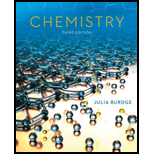
Concept explainers
(a) The free Cu(I) ion is unstable in solution and has a tendency to disproportionate:
Use the information in Table 19.1 to calculate the equilibrium constant for the reaction. (b) Based on your results in part (a), explain why most Cu(I) compounds are insoluble.
Interpretation:
The equilibrium constant (
) for the given reaction is to be calculated. The reason behind
compounds being insoluble is to be explained.
Concept introduction:
The change in free energy is called Gibb’s free energy and is represented as
If
The standard cell potential can be calculated by the expression as:
The standard Gibbs free energy change is calculated by the expression as:
Here,
is the standard cell potential, and
The equilibrium constant is calculated by the expression as:
The relation between free energy change and standard free energy change is as:
Here,
is the gas constant, and
At equilibrium the above equation is reduced to the expression:
Answer to Problem 79AP
Solution:
a)
b) Stable compounds containing
Explanation of Solution
a) The equilibrium constant for the reaction
From table 19.1, the electrode potential of two half-cell reactions are given as follows:
The Gibbs free energy for first half of the reaction is given as follows:
Substitute
The Gibbs free energy for second half of the reaction is given as follows:
Substitute
The overall reaction by the two half-cell reactions is given as follows:
The total standard Gibbs free energy is calculated as follows:
Now, the equilibrium constant is calculated as follows:
Substitute
Therefore, the equilibrium constant for the reaction is
b) Most
According to part (a), the free
Want to see more full solutions like this?
Chapter 22 Solutions
Chemistry-Connect Plus Access
- The following reactions all occur in a blast furnace. Which of these are redox reactions? (a) 3Fe2O3(s)+CO(g)2Fe3O4(s)+CO2(g) (b) Fe3O4(s)+CO(g)3FeO(s)+CO2(g) (c) FeO(s)+CO(g)Fe(l)+CO2(g) (d) C(s)+O2(g)CO2(g) (e) C(s)+CO2(g)2CO(g) (f) CaCO3(s)CaO(s)+CO2(g) (g) CaO(s)+SiO2(s)CaSiO3(l)arrow_forwardPlatinum(II) forms many complexes, among them those with the following ligands. Give the formula and charge of each complex. (a) two ammonia molecules and one oxalate ion (C2O42-) (b) two ammonia molecules, one thiocyanate ion (SCN-), and one bromide ion (c) one ethylenediamine molecule and two nitrite ionsarrow_forwardA constant current of 1.40 amp is passed through an electrolytic cell containing a 0.100 M solution of AgNO3 and a silver anode and a platinum cathode until 2.48 g of silver is deposited. a How long does the current flow to obtain this deposit? b What mass of chromium would be deposited in a similar cell containing 0.100 M Cr3+ if the same amount of current were used?arrow_forward
- A constant current of 1.25 amp is passed through an electrolytic cell containing a 0.050 M solution of CuSO4 and a copper anode and a platinum cathode until 3.00 g of copper is deposited. a How long does the current flow to obtain this deposit? b What mass of silver would be deposited in a similar cell containing 0.15 M Ag+ if the same amount of current were used?arrow_forwardAn aqueous solution of an unknown salt of vanadium is electrolyzed by a current of 2.50 amps for 1.90 hours. The electroplating is carried out with an efficiency of 95.0%, resulting in a deposit of 2.850 g of vanadium. a How many faradays are required to deposit the vanadium? b What is the charge on the vanadium ions (based on your calculations)?arrow_forwardThe transition metals form a class of compounds called metal carbonyls, an example of which is the tetrahedral complex Ni(CO)4. Given the following thermodynamic data (at 298 K): (a) Calculate the equilibrium constant for the formation of Ni(CO)4(g) from nickel metal and CO gas. (b) Is the reaction of Ni(s) and CO(g) product- or reactant-favored at equilibrium? (c) Is the reaction more or less product-favored at higher temperatures? How could this reaction be used in the purification of nickel metal?arrow_forward
 Chemistry & Chemical ReactivityChemistryISBN:9781337399074Author:John C. Kotz, Paul M. Treichel, John Townsend, David TreichelPublisher:Cengage Learning
Chemistry & Chemical ReactivityChemistryISBN:9781337399074Author:John C. Kotz, Paul M. Treichel, John Townsend, David TreichelPublisher:Cengage Learning Chemistry & Chemical ReactivityChemistryISBN:9781133949640Author:John C. Kotz, Paul M. Treichel, John Townsend, David TreichelPublisher:Cengage Learning
Chemistry & Chemical ReactivityChemistryISBN:9781133949640Author:John C. Kotz, Paul M. Treichel, John Townsend, David TreichelPublisher:Cengage Learning General Chemistry - Standalone book (MindTap Cour...ChemistryISBN:9781305580343Author:Steven D. Gammon, Ebbing, Darrell Ebbing, Steven D., Darrell; Gammon, Darrell Ebbing; Steven D. Gammon, Darrell D.; Gammon, Ebbing; Steven D. Gammon; DarrellPublisher:Cengage Learning
General Chemistry - Standalone book (MindTap Cour...ChemistryISBN:9781305580343Author:Steven D. Gammon, Ebbing, Darrell Ebbing, Steven D., Darrell; Gammon, Darrell Ebbing; Steven D. Gammon, Darrell D.; Gammon, Ebbing; Steven D. Gammon; DarrellPublisher:Cengage Learning Chemistry: The Molecular ScienceChemistryISBN:9781285199047Author:John W. Moore, Conrad L. StanitskiPublisher:Cengage Learning
Chemistry: The Molecular ScienceChemistryISBN:9781285199047Author:John W. Moore, Conrad L. StanitskiPublisher:Cengage Learning Chemistry: Principles and ReactionsChemistryISBN:9781305079373Author:William L. Masterton, Cecile N. HurleyPublisher:Cengage Learning
Chemistry: Principles and ReactionsChemistryISBN:9781305079373Author:William L. Masterton, Cecile N. HurleyPublisher:Cengage Learning Chemistry: Principles and PracticeChemistryISBN:9780534420123Author:Daniel L. Reger, Scott R. Goode, David W. Ball, Edward MercerPublisher:Cengage Learning
Chemistry: Principles and PracticeChemistryISBN:9780534420123Author:Daniel L. Reger, Scott R. Goode, David W. Ball, Edward MercerPublisher:Cengage Learning





